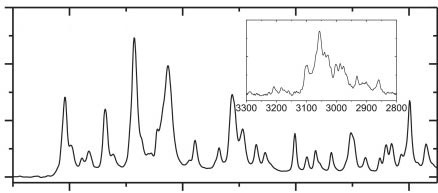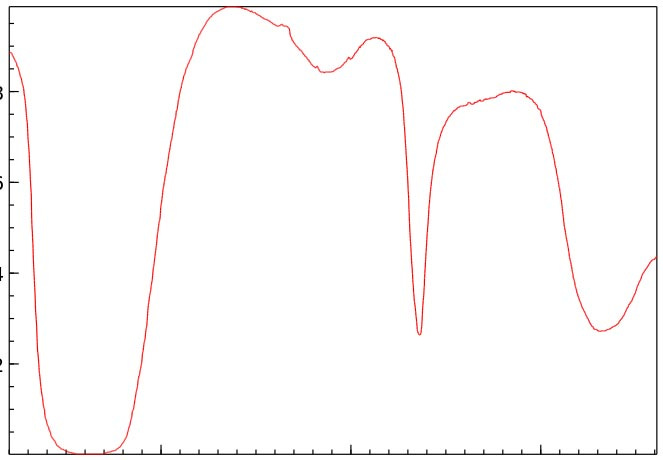Rebel Roundup Vol. 1
Everything you've missed plus everything you should be paying attention to
It’s extremely challenging to juggle managing my own survival and using my own limited time, money, and resources to provide information and education to the public about drug market trends and harm reduction that’s rooted in the 8 principles that everyone keeps trying to ignore/cast aside. So, I’m going to, at least in the meantime, leverage Substack to provide regular updates about what’s going on and how these projects can be supported. To those contributing funds on my Open Collective or paying for Substack, thank you. It’s not enough to keep me from being behind on rent and utility bills every month, but it’s better than nothing.
Wet Samples Project
I am in regular monthly meetings with members of the Massachusetts Drug Supply Data Stream (MADDS) who are responsible for spearheading and funding this project—and have been extremely supportive since the day I made phone calls to Bruker (in October 2022, quite literally while waiting in the terminal for my flight out of Puerto Rico from the National Harm Reduction Conference) to procure the FTIR spectrometer that was graciously donated to me by a philanthropist who was present during my final pitch of the David Prize. If it were not for this donor, I would not be able to do this important work. I am uniquely positioned to act as a consultant for literally anyone who requires drug checking for any purpose (personal consumption, safe supply distribution, supply tracking/emerging threat research and reporting, etc.), and through this research, we will be able to provide guidelines and protocol that will be helpful for all FTIR spectrometer technicians moving forward.
Project Summary:
As community based drug checking programs grow and expand, there is increasing interest in testing of wet samples. Programs turn down wet samples due to limitations of their testing technology, the high cost of lab testing that is capable of processing wet samples, and lack of clear technique to conduct real-time testing, among other reasons. Indeed, if a program did not want to decline a wet sample, there is little guidance available on how to best handle the sample, what testing approach should be used or how it should be packaged for shipping it to a lab. As a result, many sample types (vape carts, GHB, wet cottons, etc) are difficult or impossible to test. This project aims to address this gap by establishing a collaborative group of testing personnel to identify best practices from their collective experiences.
Background:
You may have heard about this project through organizations such as Lighthouse Learning Collective. For folks that are new to my work or haven’t been paying attention for the last several months (honestly, years), this project is 99.9% likely a result of me being literally up EVERYONE’S ass about being able to test things such as HRT, which often come in liquid (tincture/injectable) forms. For the last year and a half, I have been working with and testing for underground networks that supply these types of substances, but they are very difficult to test with the FTIR spectrometer, and current drug checking protocols suggest or even teach others in training that testing these types of samples is not possible—an assumption which I’ve COMPLETELY blown out of the water by not only successfully testing liquids, but testing liquids that were used as solvents on plant materials to extract substances that could not otherwise be accurately scanned with the FTIR. Since then, dozens of these samples have been verified by LCMS via Kykeon Analytics. Needless to say, I was fucking right, and if people have not been paying attention or taking the work I do seriously before, it’s even more important to do so now, as people’s access to drugs—including medications they may have previously been prescribed, may become inaccessible and more people WILL resort to DIY and alternative supply.

Results so far:
There are no official results as the project just started and I just got the PPE and safety materials mailed to me. There are 6 advisors on this project and 5 teams of technicians from various New England-based organizations, with me being the outlier in NYC and also operating completely outside of any sanctioned organizational context or framework other than my own. However, the timeline of this project hasn’t prevented me from experimenting, make some discoveries, and having occasional success.
I have been able to identify Ketamine with high confidence in an injectable solution using techniques that I’ve been pioneering.
I have been able to successfully isolate minute amounts of the expected substance from bulking agents in capsules. These bulking agents are typically fats or other substances that are insoluble in just about every common solvent. When the expected substance is present in amounts that may fall under the 5% limit of detection for the spectrometer and 95% of the sample material is some bullshit like microcrystalline cellulose, “cement”, or “tooth powder” (most likely calcium carbonate), it makes it hard to accurately identify (if it can get a hit at all) the active ingredient(s). So far I have been able to successfully do this with Anavar (Oxandrolone) and I’m still working out techniques to make this more successful with pills containing suspected benzodiazapines or opioids that are active in low mg amounts (expected to be things like Oxycodone, but is commonly a type of nitazene—knowing which is important as the relative potency to morphine or fentanyl varies widely). Ideally, we want to be able to dissolve these fillers entirely. Most are water soluble, but water signal on the FTIR absorbs most of the infrared light, turning a scan that looks like this:
Into this:
Even when water is evaporated, any moisture retained in the sample still produces an overwhelming signal for water that quite literally drowns out identifiable peaks of other substances. Also, it takes forever for water to evaporate at common room temperatures compared to something that is volatile at room temperature (like ethyl alcohol), or a substance like acetone, that, even when detected by the FTIR, produces signal in the IR frequency range that is not particularly essential for the identification of many drugs, and is pretty easy to subtract without losing important IR data.
I’m in the process of procuring 3 more solvents that should help with some of the challenges stated above that shouldn’t be anymore sketchy than the solvents I already have (they’re all products with OTC consumer uses).
As previously discussed, synthetic substances infused into plant materials can be detected with the use of solvents like ethanol, acetone, or methanol. THC from natural cannabis leaf can also be detected without any solvent. I don’t even think anyone even TRIED to put weed on a damn spectrometer before declaring that it couldn’t be tested. Sure, it’s not going to pick up a bunch of minor terpenes, etc. but the THC and CBD is there for folks who are concerned that their weed is not cannabis at all.
GBL solution has been easily tested on the spectrometer. It’s concentrated enough that it being mixed into a water-based solution is mostly irrelevant. I suspect this would also be true with GHB—if anyone had any that was real that isn’t already prescribed Xyrem.
Codeine and Promethazine is extremely tricky to isolate from the syrup, especially since it exists in very low concentrations per mL of the solution. This is one that requires a lot more experimentation. It would probably have to be diluted and filtered a similar way that one would extract DXM from cough syrup.
Popper (nitrites) should be testable even without the special gas module, but if not, the FTIR has other attachments that allow for a broader range of substance analysis.
FTIR Spectrometers with a diamond ATR crystal (which is probably damn near all of them at this point, unless folks are working with an older build of the Alpha/Alpha II that uses the ZnSe ATR crystal) can withstand pH levels between 1-13 or 14 if I’m remembering correctly. This means you can put just about anything highly basic or acidic on it without issue, like bleach or acetic acid (it’s in vinegar in low concentrations), meaning there’s LOTS of room to work with wet samples and solvents. There’s this irrational fear that these machines are fragile. No, the machines are sturdy af—it’s the software (OPUS) that is a poorly programmed piece of shit. I can’t speak to the Mobile IR. It seems like a piece of shit also, considering how many times I’ve seen questions from technicians about why it randomly doesn’t scan/turn on.
Disclaimer:
Much of this information should have already been known by technicians if anyone had even read the manuals/paperwork that came with the machine. Everyone likes to talk about how I broke a crystal on a machine 5 years ago, but nobody talks about how I was literally taught by another US-based spectrometer technician to do that, when it states in the instruction manual NOT to do that. I had no access to a manual when I didn’t own a machine, I was trusting the information I had been given by more experienced technicians.
Recent Secondary Lab Results:




903171 - Desert Stardust Mushroom Gummies - Blue Raspberry
4-AcO-DMT - Psilacetin, also known as 4-acetoxy-DMT or 4-AcO-DMT, is a semi-synthetic serotonergic psychedelic drug that is often considered an alternative to psilocybin, as they are both believed to be prodrugs of psilocin.
Why Does This Test Result Matter?
Personally, I love 4-AcO-DMT, however, it is very potent in sub 20mg amounts, and dosing and ingredients are shrouded in mystery in these products. Not to mention that they state that they are selling legal tryptamines.
4-AcO-DMT is absolutely NOT legal. It’s not explicitly scheduled and illegal per the DEA Controlled Substances List, but it’s definitely covered by the Federal Analogue Act. It’s questionably even in the legal “gray area”. For a substance like this to fall into legal territory, it generally would have to be considered “not for human consumption” and/or “research purposes only”. This is very clearly intended for human consumption, as they are edibles and they give instructions for dosing lmao.
Just be aware this product is not actually legal, and in the majority of places, being in possession of this substance would easily be charged as a felony, so just be aware of that if you’re going to buy and utilize these products.
903131 - Tusi/Tucci/Tusibi AKA “Pink Cocaine” (it’s labeled as Ketamine expected, but that’s incorrect).
N,N-dimethylpentylone - Also known as Dipentylone or Dimethylpentylone is a substituted cathinone derivative (synthetic cathinone) with stimulant effects.
heroin - Self explanatory
6-monoacetylmorphine (6-MAM) - One of 3 active metabolite often found in heroin synthesis.
ketamine - Self explanatory
Trace: glycerin + methamphetamine
While Tusi is sometimes called “Pink Cocaine”, it is not actually intended to have cocaine. Classic versions of this substance contain a mixture of MDMA, Ketamine, and Caffeine. There’s been a lot of media around this due to it being a substance named in the Sean Combs trial, however, I’ve been hearing about this stuff coming out of the global south since 2018, and the mixtures pretty quickly deviated from the original formula once gaining popularity amongst US user bases.
Why Does This Test Result Matter?
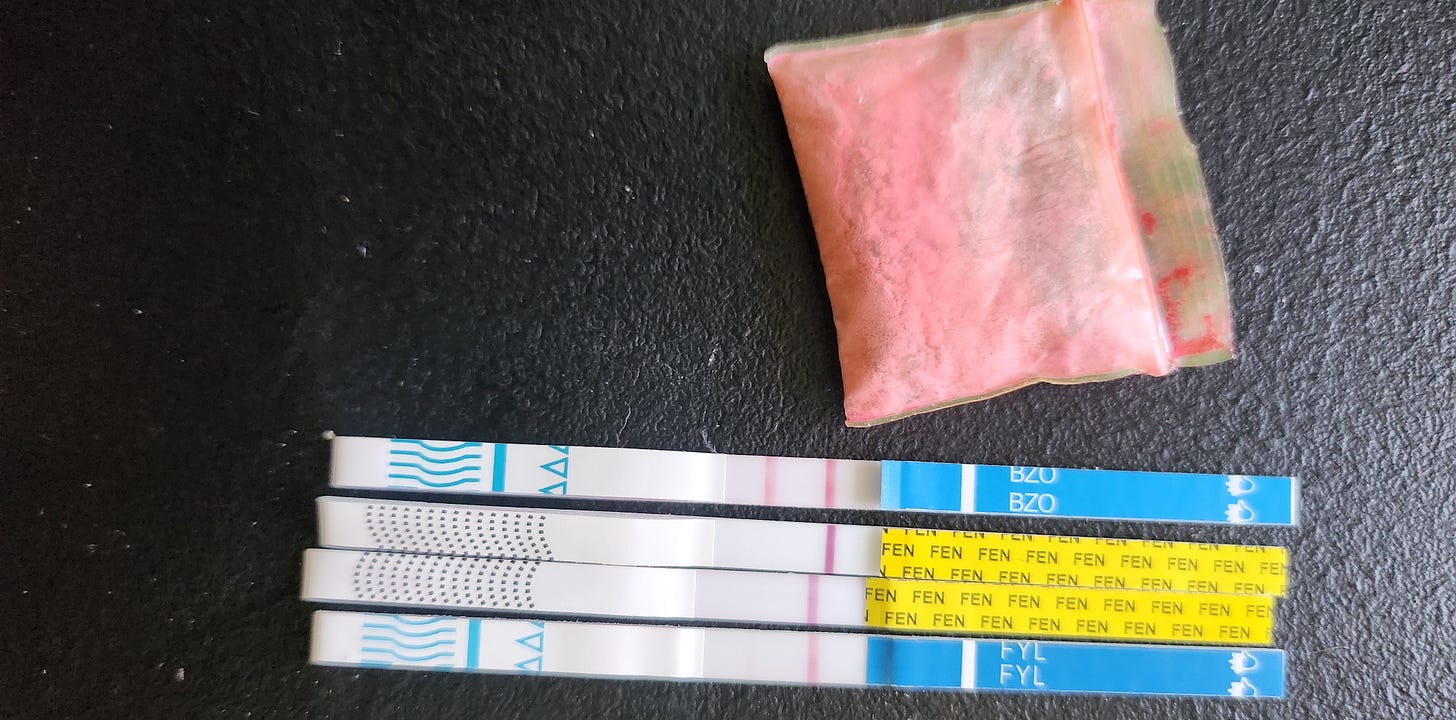
Because what the fuck is this concoction? Honestly, pretty mind-blowing that pure heroin was found in this awful Tusi imitation, but heroin is nowhere to be found in most of the opioid supply. I’ve given you the ingredients of Tusi. You’re better off mixing these 3 things together to your own liking than taking a gamble on someone dyeing some random bullshit pink and selling it to you as this product.
903129 - Product sold as Flualprazolam online
MTMP (MMMP) - A a substituted cathinone (synthetic cathinone). It used in the production of UV curable inks, to speed drying during printing, and in colored coatings and its toxicity in humans is unknown. This product is intended for research and forensic applications.
N-pyrrolidino isotonitazene - Also known as Isotonitazepyne, its in vitro potency is approximately 1000 times that of morphine.
Why Does This Test Result Matter?
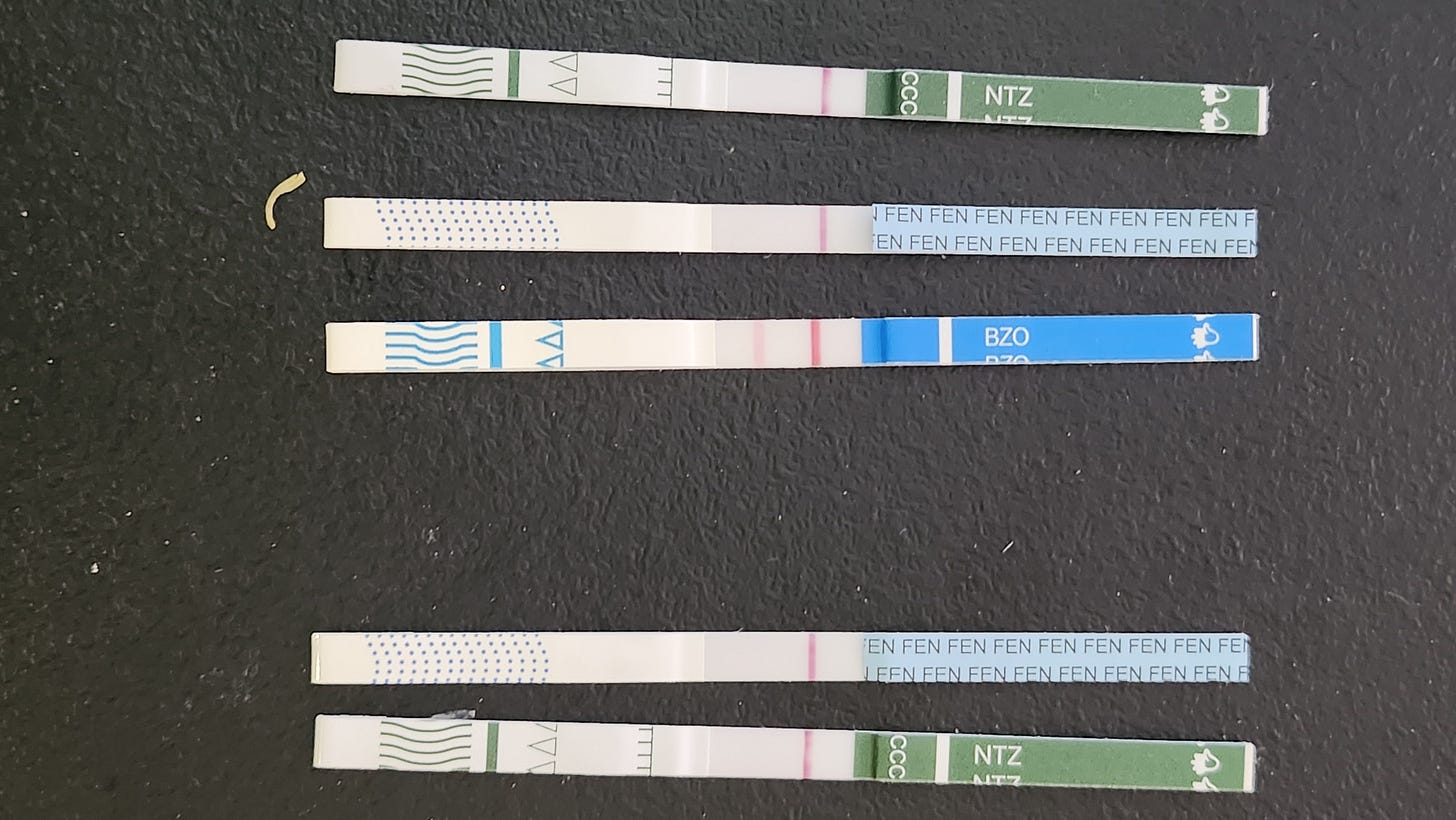
It contains an extremely potent opioid that was being sold as a benzodiazapine and it caused the user to overdose, needing naloxone to be revived. Last update I received, despite the vendor being notified of these results months ago, the product is still being sold. I believe that nitazenes are a bigger issue than we’re discussing, because in North America, there’s so much fear and focus on fentanyl—however, fentanyl supply is starting to dry up, so we will most definitely be seeing newer opioid adulterants and substitutes increase in the supply. Rapid Response Nitazene test strips have officially been 3rd party lab verified, and I endorse its use for competent drug checkers and drug checking programs. You can learn more about testing resources on this site I maintain.
903123 - A tannish/orange-ish powder that was obtained around the Columbus/Reynoldsburg, Ohio area.
xylazine - A non-opioid sedative, analgesic, and muscle relaxant only authorized in the United States for veterinary use that can cause gnarly wounds and infections that do not heal quickly, prolonged and increased sedation that isn’t reversible with naloxone or other opioid antagonists, and a number of other health issues that may occur with short-term or long-term use.
acetaminophen - It’s the active ingredient in Tylenol, so likely exists as just a cut/buffer
mannitol - A type of sugar that is used for diuretic applications and is commonly found in street opioid/sedatives.
fentanyl - self explanatory
4-ANPP - A marginally active common byproduct of illicit fentanyl synthesis
Trace: quinine + methylenedioxynitazene + p-fluorofentanyl + erythritol
Why Does This Test Result Matter?
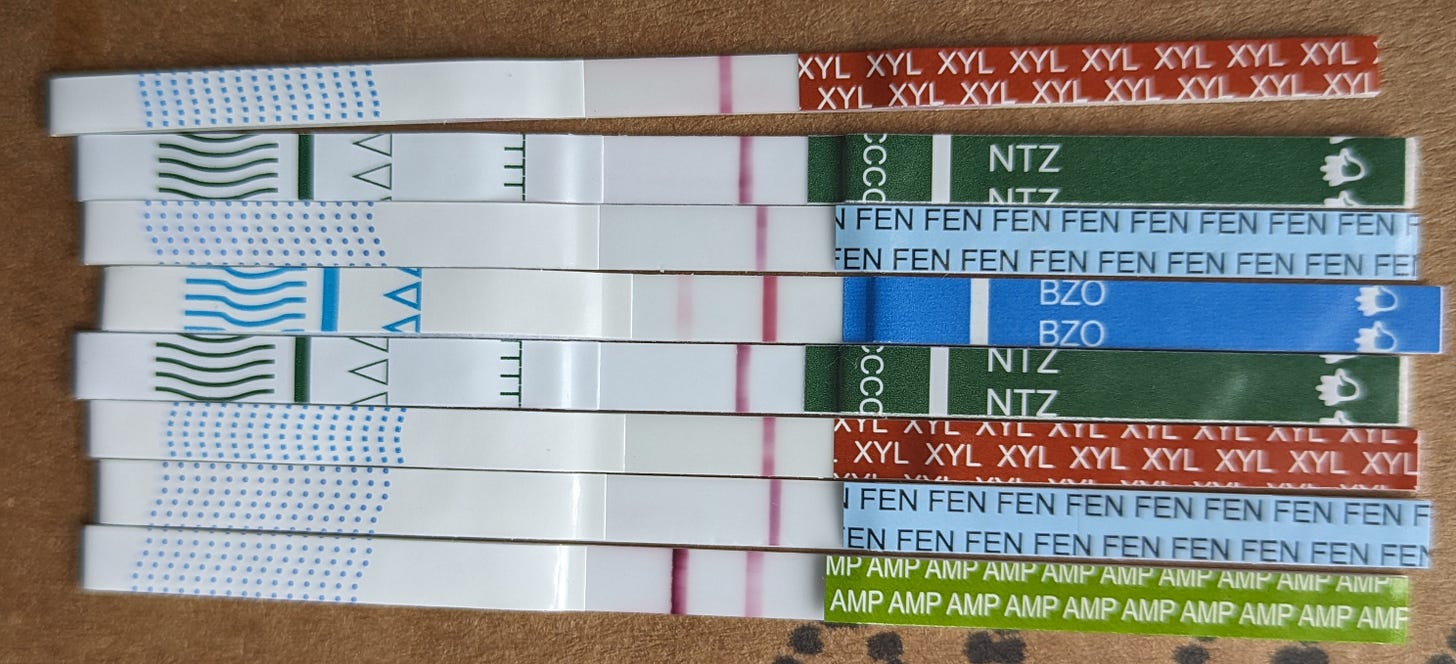
Most of these substances were detected by FTIR and test strips and had already raised a huge red flag when the Nitazene test strip was positive and I could not find caffeine or other known/potential substances that would cause a false positive in the sample. While the GCMS only detected “trace” amounts of nitazenes and p-fluorofentanyl, it’s likely that there were active amounts somewhere in the sample. I only had 5-10mg of powder to work with. 100% of it went on the spectrometer for analysis, and then I had to sacrifice it all to run strip tests. In order to dilute it to appropriate ratios to factor out caffeine causing a false positive on the test strip, I had a lot of saline solution diluting the sample and I had to send in random amounts of mixed saline for analysis. I ran tests on a different opioid sample from the same area, and the results were less alarming. This shows the how vastly different the supply can be from vendor to vendor in the same community.


There are no drug checking agencies in Ohio and therefor supply data is generally unavailable. I procured these samples during my annual visit to Gathering of the Juggalos, and to assist with harm reduction and drug checking services at the festival that has a diverse demographic and wide variety of drug use. For folks that are not aware, I spent my early adult years living in Ohio in the middle of Opioid Crisis 2.0(?) (Oxycontin era) and all the homies LOVED railing opioids, amongst other things. Opioid users in Ohio, be vigilant. Test before you ingest!
Closing Thoughts
There are a number of folks and institutions that have participated exclusionary bullshit that has resulted in drug checking falling short of its full potential. I take measures that require an extraordinary amount of effort that is unreasonable for any unfunded individual with no legal protections and no chemistry background to undertake. That being said, shout out to Energy Control and Kykeon Analytics, The Loop, BCCSU, Interior Health (Antoine Marcheterre, specifically), Chicago Recovery Alliance (when Maya Doe-Simkins or Loki was there), and Brandeis University for supporting me in various ways over the years.




